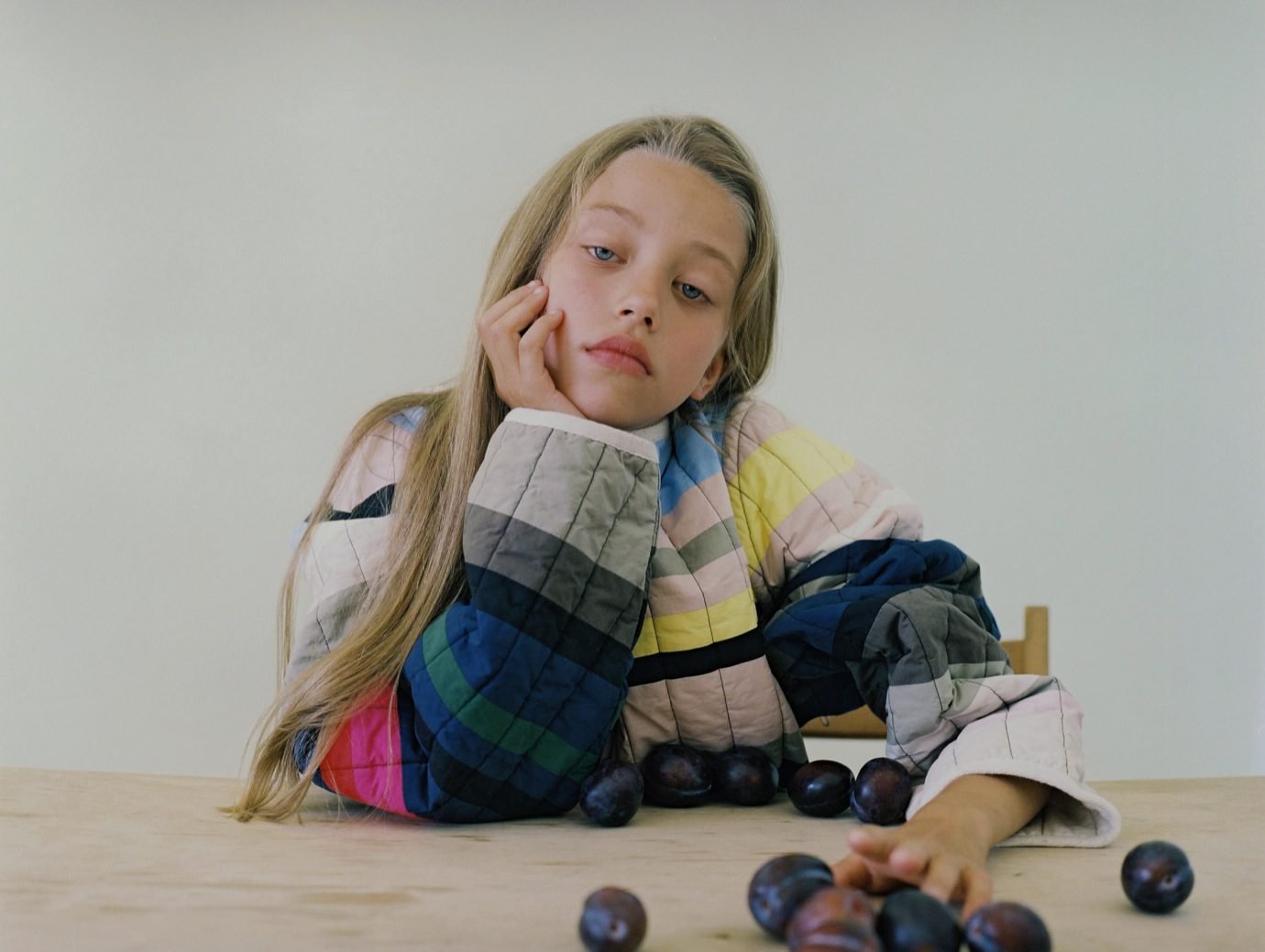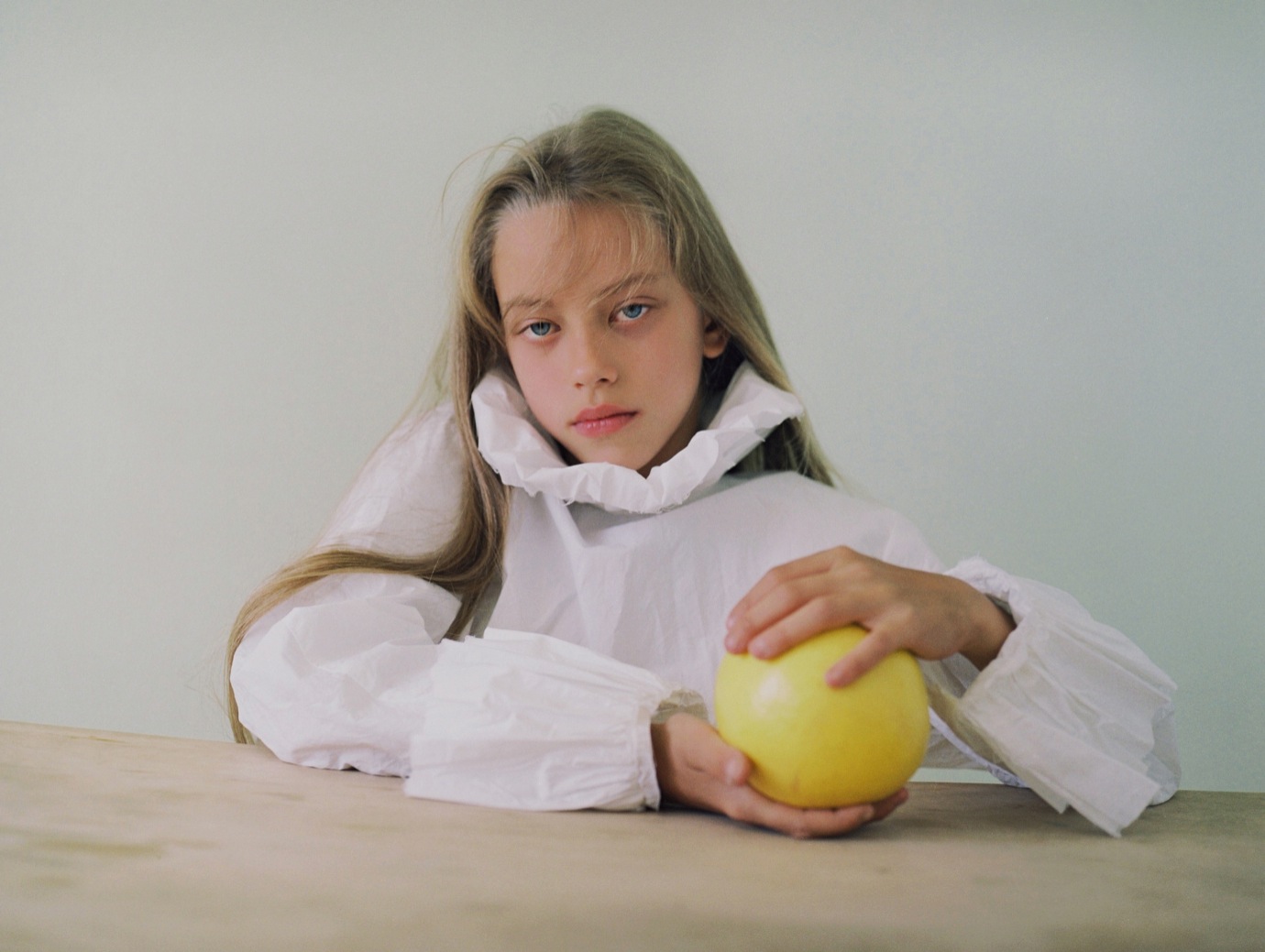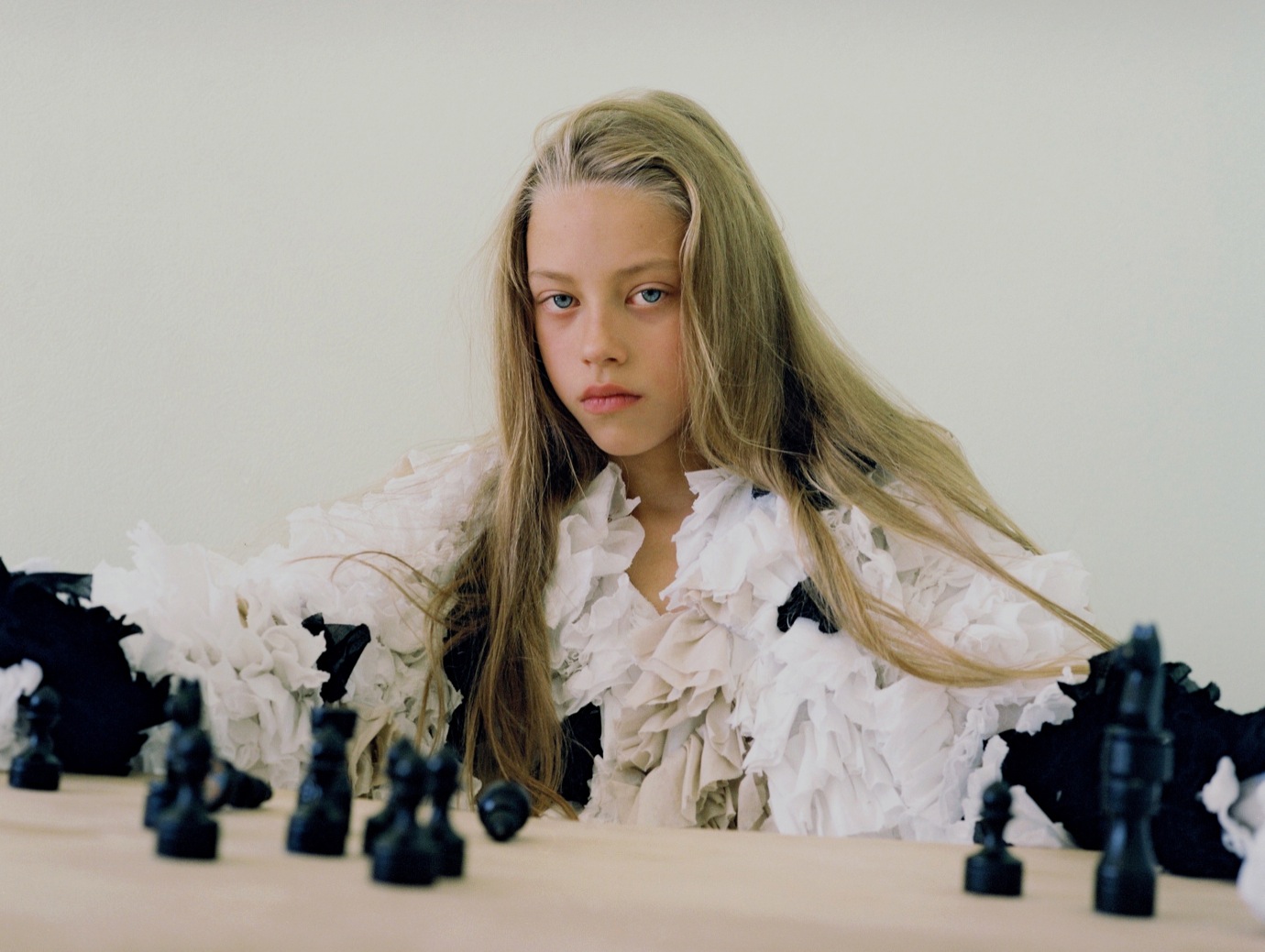“WHEN YOU HAVE A COMMON CAUSE, YOU FEEL RESPONSIBLE NOT ONLY FOR YOURSELF BUT ALSO FOR THE OTHER PERSON. YOU BECOME TWICE AS STRONG.”
Russia is not particularly famous for its fashion industry. As designer duo Nina Neretina and Donis Pouppis from the label Nina Donis argue: that’s because it’s pretty non-existent. Yet, it’s exactly the place where they have produced collections for the past fifteen years, enjoying the freedom that the world’s largest country gives them. A couple in both life and work — they’ve known each other for 28 years — their collections reference many of their direct as well as distant influences: from their daughter’s Lego toys scattered throughout the house, to Grace Coddington, A Clockwork Orange, Russian folk costumes and the Blitz club. Each season, they share this wealth of research imagery online, coming forth from their reluctance of giving interviews and preferring to let the visuals speak for themselves. Here, they tell us about their synergy, politics and optimism, and the reality of working as a designer in Russia while showing in London and Milan.
Where did you meet, and what made you form a collaboration? Was there a particular moment you remember taking that decision?
We met at the Moscow Textile Academy in 1987. We were studying in the same group, which is when we started our friendship, living and working together. It happened by itself, naturally and easily, and it’s been going like this for over 20 years. Even then, we knew that we liked working together, we enjoyed the process and the results. After our graduation in 1992 we decided to stay in Russia and start our own business, despite the fact that those were tough times. But as many other Russian people, we had faith that everything would change and get better eventually. In 2000, with the same faith, we established our brand.
How do you enjoy collaborative work? What are the benefits?
When you have a common cause, you feel responsible not only for yourself but also for the other person. You become twice as strong. You always have this opportunity of getting advice from someone with similar spirit and thoughts as you, someone who cares about the work just as much as you do. Over the years we have become one. Often, a thought begins in the head of one and finishes in the mind of the other. But we are together not because of work. The work is here today, but possibly not tomorrow. We are together just because we are together.
It feels a very candid approach to display your mood-board along with each of your collections on your website. Considering fashion’s very appropriative culture, where in many designers rather not divulge their thoughts and ideas, why do you choose to do this?
We don’t like to give interviews, describing our collections. We are more about images than words. But we also understand that it’s necessary to communicate. That’s why at some point we decided that it’s easier to show our moodboard, rather than describe our thoughts. It seems to us that this works better. Even people who are not too involved started understanding what we are talking about.
I can’t help but draw parallels between a certain Russian sensibility in the structure of your silhouettes and palettes, especially making me think of Kazimir Malevich and Supremacist art, though also a varied inclusion of other European styles (and much homage paid to the individual style of the of artists and pop stars alike, such as Basquiat and David Bowie). With both of you having artistic origins, would you say this is a conscious inclusion of art inspiration, is it important for you to look at art in this way for your collections?
We are inspired by everything that interests us or just grabs our attention. This can be our daughter’s Lego toys that are scattered throughout the house or a recently watched movie about Alexander Calder “From the circus to the Moon” at the Pushkin Museum, where the artist showcases his toy circus.
Of course art inspires us. It’s a powerful source of emotions, of energy and feelings, very varied but constant. We rely more often on Russian and Soviet art, because, for obvious reasons, it’s closer to us. It’s clearer and better understood. It’s the foundation of our aesthetic views.
Pop culture has its own bright moments, and sometimes when the settings are right it’s possible to get a strong charge from it too.
“THERE’S NO FASHION SYSTEM IN MOSCOW, THERE IS NO INDUSTRY AND MECHANISM, SO YOU CAN DO WHATEVER YOU WANT AND ENJOY THE FREEDOM.”
Would you classify yourselves as being a particularly ‘Russian’ brand, both in terms of profile and aesthetic universe?
Yes, we are Russian designers. We are saying this without pathos, just with dignity.
Vintage sportswear, or perhaps general activewear and utility is something that’s referenced many times over and runs deep throughout your collections, where does this fascination with the fabrics, textures and silhouettes of active wear come from?
We think that sports clothing and footwear most closely corresponds to the principles of modern design and the modern world. It’s always the most comfortable and functional, without much decoration but with a clear designation of the information signals, often with the use of new technologies. So everything connected with this is interesting to us. In addition to sportswear, for the same reasons we have a lot of interest in different kinds of uniforms. Often when we look at such clothes we are reminded: Yes – this is the 21st century!!! Such thoughts rarely appear when we look at seasonal fashion shows.
The model Polina Ogonicheva has been used for your most recent lookbooks and the models of your previous lookbooks follow a similar aesthetic. Does they personify a particular aspect of your design? Does this represent the desired wearer? Who might that be?
‘The right model for a lookbook’ is a difficult topic. We care not only about the appearance, but also about the mood and emotions that the person brings. It’s a big mistake to think that clothes make a man, and not vice versa. To find a nice girl with the right mood is a huge success. We believe that we were very lucky with Polina, it’s easy to work with her, she looks perfect in our clothes and precisely illustrates the type of girl that we find pretty. We like her fresh face and a quiet and decent presentation of the clothing. But the fact that she has been presenting our collection for three seasons in a row is not a planned step, just a series of coincidences.
I notice Russian folk costume and films crop up a few times in the moodboards of your collections. What other parts of Russian history and culture do you draw upon for your collections? Is there a message you wish to communicate in doing so?
Russian history, art and culture are a permanent part of our mind’s moodboard. Apart from Constructivism and Suprematism (the most famous art directions outside of Russia) there’s a lot more that inspires us: literature, folk costume, Soviet architecture, posters and cinema, Yuri Gagarin, 80’s Russian rock, raves of the 90’s… It’s hard to recall everything. At all times, in different cultural and scientific areas, under different regimes, in Russia there were always talented, brilliant people who created incredible things.
“THERE WAS TIME WHEN WE WERE TRYING TO FIND A RELIABLE BUSINESS PARTNER WHO WOULD BE ON THE SAME WAVELENGTH AS US, BUT WITH TIME WE CAME TO REALIZE THAT IN RUSSIA NO ONE TAKES FASHION SERIOUSLY AS A BUSINESS THAT CAN MAKE MONEY.”
Having begun your journey in 2000, showing your collections in London and Milan, given the scale at which you’ve been operating, you’ve been active a tremendously a fair while and you’ve seen the fashion industry go through some tumultuous times.
Before our decision to go to the London Fashion Week and show our collections in Milan, we were able to take part in a variety of fashion competitions and festivals from Moscow to the famous Hyeres Fashion Festival (2001), where we received the prize for the ‘Best Mix Collection’. After that we decided to try and show our collections during professional fashion weeks and exhibitions. We went to London and Milan with the hope that we could expand from Russia to the international fashion market, but because of a variety of reasons in our country – the laws, bureaucracy, corruption – this was impossible. We tried for a few years, in different ways, but eventually realized that it was useless. It’s sad, because we feel there’s a lot of interest in what we do, and we also received really good orders.
Would you cite anything in particular as contributing to your longevity?
It’s something that we first and foremost love to do. And only incidentally does it also happen to be work. The second possible reason is that we are free, there’s no one above us, so we can decide by ourselves what we should do.
Was business something that always interested you, or was it something you had to learn? What has been the hardest part of the business side of your project?
Unfortunately, or maybe fortunately, business is not something that interests us in life, we are still learning and still making lots of mistakes. There was time when we were trying to find a reliable business partner who would be on the same wavelength as us, but with time we came to realize that in Russia no one takes fashion seriously as a business that can make money. In Russia, business is usually something that you invest in today and get money from tomorrow. Other options are not considered.
What was your experience of the European fashion circuit?
We realized that the European fashion circuit is a well-established mechanism and business, that once you’ve entered it you have to get into tune with it, following its way. If you don’t — you are out.
“WE ADMIRE PEOPLE WHO CLEARLY AND DIRECTLY SHOW THEIR POLITICAL POSITION, AND ALSO WHEN THIS IS REFLECTED IN THEIR WORK. WE ARE NOT APOLITICAL PEOPLE. WE CAN’T SEPARATE POLITICS EITHER FROM OUR WORK OR FROM OUR LIFE. IT’S IMPOSSIBLE TO DO.”
What is your experience of the Moscow fashion scene? Do you enjoy a lot of support there, and how is it different from say Milan and London?
There’s no fashion system in Moscow, there is no industry and mechanism, so you can do whatever you want and enjoy the freedom. The downside is that you can’t do anything serious in terms of business. We are trying to find our own way, to make a living and also do business, from which we get enormous pleasure.
How has your design process, ethos or approach changed over the years you’ve been active?
We started doing fewer unnecessary things in our profession. We realized that the desired result can be achieved by relatively modest means and actions, although it’s necessary to build everything clearly in your mind. We were always after simplicity and are confident that brevity and clarity of thought is a great strength.
You’ve had a slew of accolades throughout your active years and have garnered the support of many. With stockists worldwide, how have you dealt with the establishing and growing of your clientele and customer base? How do they inform your design process?
We’re not in many stores outside Moscow (and in Moscow in just two, but the best ones). For a long time, since we last showed in London and Milan, we sold nowhere else except in Moscow. In the last few years, since we moved to Cyprus (our studio and our heads), we’ve been trying again to pave the way to selling in stores around the world. However, it’s just a beginning.
Your works strikes me as deliberately a-political. Do you feel fashion and politics should remain separated, or can they work in tandem without succumbing as a form of propaganda? Or are the politics involved much more furtive than one would think? Many designers do so most notably through sloganeering and direct references. Is there simply another way?
We admire people who clearly and directly show their political position, and also when this is reflected in their work. We are not apolitical people. We can’t separate politics either from our work or from our life. It’s impossible to do.
Almost everything we were saying in this interview is about that. Of course, we wouldn’t start a conversation with politics, we would start it with fashion design, but if we feel that we have something to say about it – we won’t remain silent.
We were always, in one way or another, saying that we are not indifferent to the fate of our country, which we love and in which we want change to happen. At different times we have expressed our political position: we used political slogans when designing the show, printed photos of people that inspire us on the invitations, including portraits of the current government opponents.
Do you have a clear strategy for the development of Nina Donis? Where would you like to go from here?
Our main strategic goal is to continue developing our business in a way that we can enjoy, and to do it for as long as we can.













